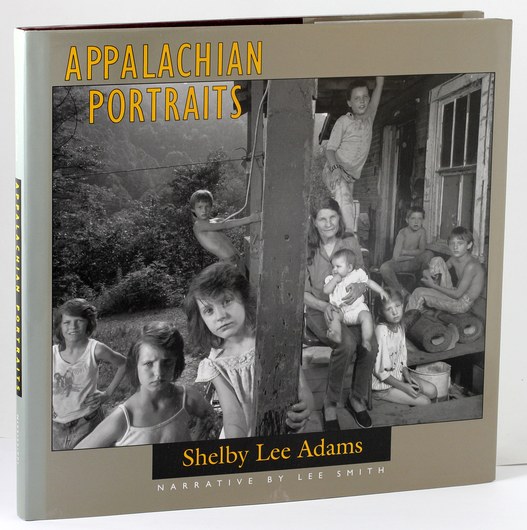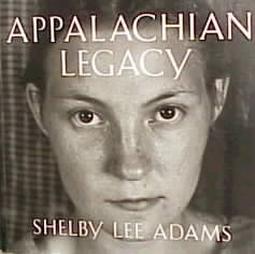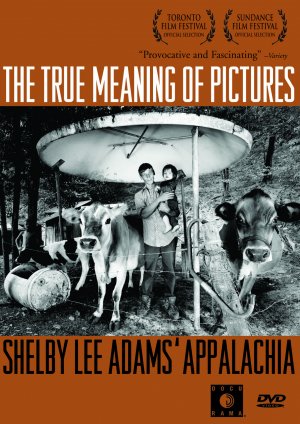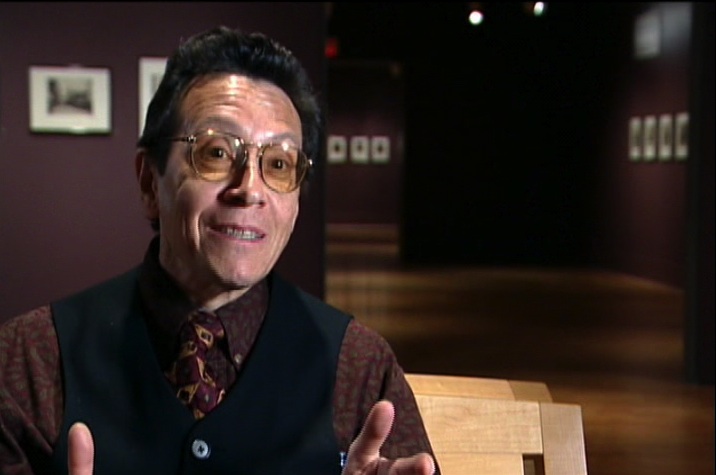 From the June-August 2005 issue of the predecessor to this blog, an online journal, “On the Front Burner,” that between mid-1995 and mid-2009 formed part of my website, C: the Speed of Light:
From the June-August 2005 issue of the predecessor to this blog, an online journal, “On the Front Burner,” that between mid-1995 and mid-2009 formed part of my website, C: the Speed of Light:
“Back in the spring of 2001 I consented to allowing Jennifer Baichwal to interview me on camera for her forthcoming film, The True Meaning of Pictures: Shelby Lee Adams’ Appalachia (Mercury Films, 2002). We did it in two sessions, the first in Toronto on May 7, 2001, the second in Manhattan on November 2, 2001.
“I find the work of Adams deeply problematic on many levels, from the conceptual to the ethical. Though Baichwal filmed me for several hours, I end up appearing in the film for somewhere around five minutes all told — hardly enough time to make a full, reasoned argument. Nonetheless, the quotes accurately represent my positions on Adams’s work and documentary, so I have no objections.
“The one thing I’d add is that I’m only one generation away from Adams’s territory myself — my mother was a West Virginia farmgirl — and spent time as a boy with my relatives down there, so my views don’t make any city-slicker assumptions about the people in his images.
“Most importantly, Baichwal’s excellent film probes usefully and intelligently into many of the troublesome issues embedded in documentary photography, especially in its relation to the creative impulses of the photographer and how those manifest themselves (for better or worse) in the resulting work. The film has gone on to win awards and other recognition. In addition to Adams and myself, it includes commentary from Mary Ellen Mark and Vicki Goldberg, among others. I’d recommend it highly not just as provocative viewing in itself but as a discussion-provoking teaching tool in classes on documentary and on the ethics of representation.”
And thereby hangs a tale.
The True Meaning of Words
Here, in their entirety and in order of appearance, are my comments in this film:
- “We begin [at photography’s birth] believing that the photograph gives us the thing itself, with no interference on the part of the photographer. And a number of threads feed into the gradual transition away from that [belief]. Photographers become more self-conscious about themselves as presences in the work. And we begin, as audience, eventually ― as the criticism of photography begins to emerge in the 1970s ― we become more aware as audience that we’re not just looking at whatever was in front of the lens, we’re looking at what the photographer has choen to show us and how the photographer has chosen to show it to us. And we can look at some of Shelby Lee Adams’s pictures and see a certain theatrical quality, a sense of the image as a kind of narrative, with events that have been in some ways set up between Adams and his subjects. I’m not sure whether he thinks of himself as a fine-artist or as a documentarian,* but the work occupies this interestingly energized but also uneasy space between the two.”
- “On some unconscious level, a lot of people do realize, ‘This [Adams’s photo of a family grouped around a butchered hog] doesn’t quite look like your average documentary photo — why doesn’t it?’ It’s not that there isn’t information in there. This family did look that way that day. But they looked that way standing in front of Shelby Lee Adams’s large-format camera with Shelby Lee Adams’s [artificial] light on them. And that has changed everything, even if we don’t know that he bought the pig, and arranged the butchering, and all that stuff.”

Shelby Lee Adams, “Appalachian Portraits” (1993), cover
- “There is to me a curious tension in the project between his commitment and feeling that he comes out of this place, he’s representing this place, he loves these people, etc. ― which I don’t doubt for a minute ― and the fact that the cumulative picture often shows me people who I really wouldn’t want to meet in a dark alley at night. And some of that may be just their physiological presence, but some of that is an ominous note that the images strike with the theatricality of their lighting and with certain other kinds of dramatic elements that he introduces that I find somewhat spooky.”
- “These are late 20th-century, early 21st-century photographs with a great deal of visual sophistication to them, and I think that they call for a very sophisticated kind of reading. And I’m not sure that the people he’s photographing have the education — the visual educational background — to understand how these pictures read. And if that’s patronizing, I apologize for it, but I just think it’s so.”
- “There’s a story implied [in one particular image] that the viewer is invited to move toward. It is not clear to me whether that story has anything at all to do with the actual people he’s photographing. Is this their inner life, or is this Shelby’s inner life, being reflected?”
- “If this is presented as Shelby Lee Adams’s southern-gothic poetry of Appalachia, that’s one thing. If this is presented as documentation of Appalachia, that’s something else entirely.”
The True Picture of Meaning
Now, I don’t consider any of these brief extracts from Baichwal’s interview insulting, to either Adams’s subjects specifically or the people of Appalachia in general. Nor to Adams. Baichwal follows that last statement of mine with a clip of photographer Mary Ellen Mark asserting ― seemingly in direct response to my comment, though perhaps not ― that “[J]ust because [Adams’s subjects] are poor certainly does not mean they’re stupid” (which I never suggested). She continues, “Even if they’re illiterate, that does not mean they’re stupid,” which I also never suggested.
However, since she raises the question of literacy, I do assert — in the comment to which Mark apparently responds here, and in almost 50 years of writing about photo education — the existence of a capacity often referred to as “visual literacy,” which I and many others consider not an innate ability but an acquired skill set.
Mark then goes on to announce that “Everyone understands what a picture is, and the possibilities of a picture.” I respect Mark’s work as a photographer, but that’s a total crock of shit. Hard to imagine anyone in the field today trotting out Edward Steichen’s naïve, hoary mid-20th-century claim that photographs speak in some universal language, understood in the same way by all, a proposition recognized as balderdash for decades.

Shelby Lee Adams, “Appalachian Legacy” (1998), cover
As I noted back in 2005, I think Baichwal did a fine job with the film, even though I come across as the “heavy.” (I actually told Baichwal during the filming that she was casting me as such; she laughed, but didn’t deny it, and her final cut bears this out.) Still, I would not have expected these brief comments to spark any controversy; they all seem self-evident to me.
Yet controversial they’ve proved — for all the wrong reasons, alas. I’ll start by dissecting, in my next post, the fabrications and nonsense promulgated by film blogger Marilyn Ferdinand in her 2009 review of Baichwal’s documentary. The website where it appeared originally, Ferdy on Films, went offline several months ago. Its apparent replacement, The Oldest Established Really Important Film Club, includes a link to the review — broken, alas.**
 But, thanks to the Wayback Machine, which archives the entire web (or most of it), you can read it here: “The Oldest Established Really Important Film Club: The True Meaning of Pictures (2002).” Make sure to browse the extensive and fascinating exchange of comments that ensued, as they represent a rare published sociological insight into the thought processes of people who, while educated, self-confessedly know next to nothing about contemporary photography but don’t allow that to stop them from opining about it.
But, thanks to the Wayback Machine, which archives the entire web (or most of it), you can read it here: “The Oldest Established Really Important Film Club: The True Meaning of Pictures (2002).” Make sure to browse the extensive and fascinating exchange of comments that ensued, as they represent a rare published sociological insight into the thought processes of people who, while educated, self-confessedly know next to nothing about contemporary photography but don’t allow that to stop them from opining about it.
A version of my exchange with Ferdinand over this review appears at the very end of that series of comments. Ferdinand truncated that exchange; I’ll present it in full in my next post.
•
* At one point in the film, Adams asserts that “As a documentary photographer, one’s job — or one’s calling — is to observe and document life.” Yet, immediately thereafter, he admits that in one situation — and, presumably, others as well — “[I]t became much more than documenting life; I became a participant.”
Later in the film, he asks, rhetorically, “If we’re doing documentary work, and we’re in the 20th century doing that, and we’re photographing difficult material, who’s to say how we could or should do it? Who’s to say what the limits and the limitations are? I hate limitations on things. I hate for people to tell me I can only do this, I should only do that, and do it a certain way.”
And he explains one picture that troubles many people as follows:
“The reason Burley is there holding a knife — which was not my idea — is that Burley had bought a new knife and wanted me to photograph him holding his new knife. I was really focusing on Homer and Selena having dinner. Homer was looking like a saintly figure to me. He wasn’t in a diaper; he was like Jesus Christ draped for the crucifixion. This is the real way my mind works. This was a metaphor that was almost a religious icon. The fact that someone is standing there with a sword could have been one of the crucifiers. And it happened to be his father — and that’s another ambiguity.”
A stew of random symbols doesn’t yield a “metaphor.” A mashup of conflicting and contradictory denotations and connotations doesn’t constitute an “ambiguity.” In any case, this doesn’t sound to me like a documentarian at work.
** I stand corrected. Per the exchange in the comments below, Ferdy on Films remains online; blogger Ferdinand has simply blocked my access to it. So you can access her review of The True Meaning of Pictures, and her visitors’ commentary thereon, by clicking on this link. The relationship between Ferdy on Films and The Oldest Established Really Important Film Club remains unclear to me, but as of this writing the link there to her review still doesn’t work.








My website has never gone offline, nor have the review or comments disappeared.
That certainly explains why, when I go to the main page of Ferdy on Films, at http://www.ferdyonfilms.com, I get a 403 Permission Denied message.
And when I go to the Ferdy on Films link to your review of The True Meaning of Pictures, at http://www.ferdyonfilms.com/2009/the-oldest-established-really-important-film-club-the-true-meaning-of-pictures/395/, I get a 403 Permission Denied message.
And when I go to The Oldest Established Really Important Film Club and click on the link to your review of The True Meaning of Pictures, at the bottom of the left-hand column, I get a 403 Permission Denied message.
Clearly fact-checking isn’t your strong suit. Attitude’s your forte, and I advise you to stick to it.
I blocked you because I didn’t want to keep responding to your comments. All of your 20 readers are welcome to read my reviews. If you wish to block me, no problem.
I’m flattered. Truly. It’s a first for me, and I treasure it. But I haven’t attempted to post any comments at your blog since our exchange last January. Nor have I read any of your other posts there, and don’t plan to do so.
As a Marxist (Groucho faction), I wouldn’t join any club that would have me as a member. Getting blackballed by a club to which I’d never apply puts a cherry on the sundae.